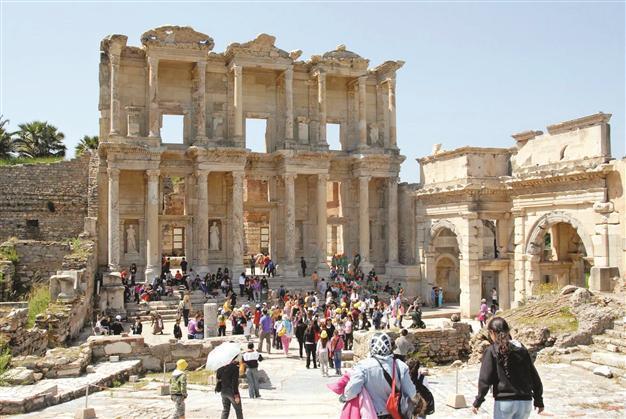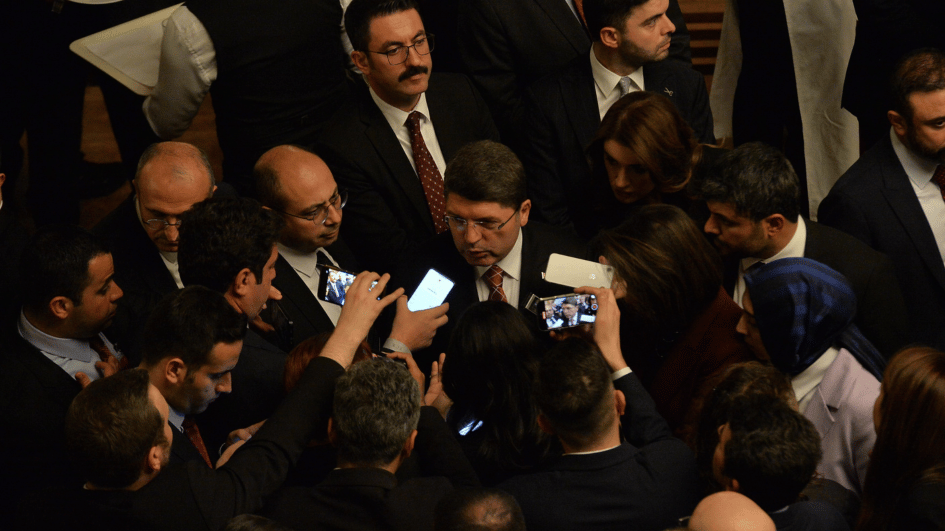Books and libraries of the past
Niki Gamm ISTANBUL - Hürriyet Daily News
 Libraries have existed in the Middle East since the ancient period, although sometimes they are rather more like archives, or collections of records. The earliest libraries come from the Sumer and the Mesopotamia areas and have been dated back as far as 2,500 B.C.
Libraries have existed in the Middle East since the ancient period, although sometimes they are rather more like archives, or collections of records. The earliest libraries come from the Sumer and the Mesopotamia areas and have been dated back as far as 2,500 B.C.Before it was destroyed in the fourth century A.D., the library at Alexandria, Egypt, was considered one of the wonders of the known world at the time. It was established around 300 B.C. by Ptolemy I, one of Alexander the Great’s generals after the latter’s death, and his successors continued to support it. It is said to have contained 700,000 volumes at the time it was destroyed by Christian mobs trying to wipe out pagan temples. Another famous library of antiquity was that of Celsius in Ephesus, which was built in the second century A.D. and contained around 12,000 scrolls.
The Great Library of Constantinople was founded in the fourth century A.D. by the Emperor Constantius II, and is said to have housed 100,000 texts before a university was established in the fifth century. However, the Latin crusaders destroyed it in 1204.
While this library was supported by the authority of the Byzantine emperors, citizens also had libraries. For example, Photios who was the Greek Orthodox Patriarch, twice collected such a large library that it was thought to contain thousands of books, and he made them available to his friends.

Books haven’t survived to the present day
Prof. Dr. Zeren Tanındı, in a book titled “The Sakıp Sabancı Museum Collection of the Arts of the Book and Calligraphy,” says of the Ottomans: “Ottoman arts of the book were rooted in the traditions of the wider Islamic world, following the fundamental idioms of these arts, which evolved and diversified there. At the same time, however, these idioms were adapted to Ottoman taste and flourished under the diverse influences of the extensive empire and its neighbors, and the pluralistic milieu at the Ottoman palace giving rise to distinctive styles that made Ottoman books recognizable at a glance. These works reflect the continuity of knowledge and skill passed down from master to apprentice, and the constant diversification fuelled by new dynamics that evolved over the centuries.”
In the years that preceded the Turkish conquest of Constantinople, many scholars and intellectuals fled the city and settled in Italy. Undoubtedly they took with them some of their precious books but probably not many. During the confusion and fires that broke out immediately following the conquest, books were destroyed. Since Fatih Sultan Mehmet knew several languages and was a learned man, it has always been thought that he would have collected ancient books and possibly he did. But if so, they haven’t survived to the present day. There had been some hope among classicists that the books kept at Topkapı might contain long lost Greek manuscripts but it proved to not be the case.
Under the Ottomans there was no policy for copying books and making them available to the general public. Copying books by hand was very expensive, and until roughly the end of the Ottoman classical period high quality paper and ink were used and the copyists were well-trained. The writer would produce the first draft and then he would have copies made to present to friends and potential patrons. They in turn would make copies. Following the classical period, the quality of handwriting and materials degenerated noticeably.
Wealthy, private citizens collected books
Libraries, such as they were among the Ottomans, were basically handwritten books collected by wealthy, private citizens and only the sultans could afford to commission large volumes illustrated with miniatures that allow us to see aspects of imperial life. On the other hand, religious books would accumulate in mosques and in the various “medresses” (schools) around the city. Medical texts might be illustrated in order to show students how to perform operations, for example.
The Köprülü Library, which is still extant today, consists of books that the famous Köprülü family gathered over the centuries. At present the library holds about 3,000 manuscripts but it once contained far more. It was founded at Çemberlitaş in 1678 by Köprülüzade Fazıl Mustafa Paşa with some 2000 books. While he was the Ottoman grand vizier, Fazıl Mustafa Paşa was killed during a battle in 1691, but other members of the family continued the tradition.
When Sultan Ahmed III returned from an extended stay at the imperial palace in Edirne in 1718, he found that no one was bothering to keep books at Topkapı Palace in one central place, so he ordered for a library to be built in the middle of the Third Courtyard. The sultan is even said to have participated in the building project and the shovel he used still exists. For many years it was possible for scholars to read there after the palace was turned into a museum, although in 1966 the book collection was transferred over to the building that was once the Ağalar Mosque. The manuscripts found there are in the Turkish, Persian, Arabic, Greek, Latin, Armenian, Serbian, Hebrew and Syriac languages.
Manuscripts
There are hundreds of thousands of manuscripts in Turkey but the largest holding is at Süleymaniye Library, located in the complex of buildings around the mosque of the same name in Istanbul. Many individual private libraries from Ottoman times have been collected there. It wasn’t initially established as a library, but rather as a school. However, in 1927 it was decided that it should act as a library in which handwritten manuscripts were collected, restored and even microfilmed. It now holds around 70,000 handwritten manuscripts in Arabic, Persian and Ottoman Turkish and another 50,000 printed books. Many of the books were originally part of individual collections.
The Millet Manuscript Library in Istanbul’s Fatih district also holds manuscripts and printed works from the eleventh to the nineteenth centuries. The building, which was also originally built as a school in 1700, has recently been restored, and holds nearly 7,000 handwritten manuscripts and nearly 30,000 books printed in Arabic letters. It is sometimes referred to the Ali Emiri Library after the man who donated his collection of books to it and served as its librarian for a number of years.
The Atıf Efendi Library in the Fatih district has another very important collection of manuscripts, of which over 3,000 have been digitized. The building was built in 1741 by an important governmental official during the reign of Sultan Mahmud I.
















